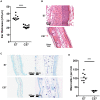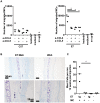HPV16-E7 expression in squamous epithelium creates a local immune suppressive environment via CCL2- and CCL5- mediated recruitment of mast cells
- PMID: 25340820
- PMCID: PMC4207828
- DOI: 10.1371/journal.ppat.1004466
HPV16-E7 expression in squamous epithelium creates a local immune suppressive environment via CCL2- and CCL5- mediated recruitment of mast cells
Abstract
Human Papillomavirus (HPV) 16 E7 protein promotes the transformation of HPV infected epithelium to malignancy. Here, we use a murine model in which the E7 protein of HPV16 is expressed as a transgene in epithelium to show that mast cells are recruited to the basal layer of E7-expressing epithelium, and that this recruitment is dependent on the epithelial hyperproliferation induced by E7 by inactivating Rb dependent cell cycle regulation. E7 induced epithelial hyperplasia is associated with increased epidermal secretion of CCL2 and CCL5 chemokines, which attract mast cells to the skin. Mast cells in E7 transgenic skin, in contrast to those in non-transgenic skin, exhibit degranulation. Notably, we found that resident mast cells in E7 transgenic skin cause local immune suppression as evidenced by tolerance of E7 transgenic skin grafts when mast cells are present compared to the rejection of mast cell-deficient E7 grafts in otherwise competent hosts. Thus, our findings suggest that mast cells, recruited towards CCL2 and CCL5 expressed by epithelium induced to proliferate by E7, may contribute to an immunosuppressive environment that enables the persistence of HPV E7 protein induced pre-cancerous lesions.
Conflict of interest statement
The authors have declared that no competing interests exist.
Figures





References
-
- Frazer IH, Leggatt GR, Mattarollo SR (2011) Prevention and treatment of papillomavirus-related cancers through immunization. Annu Rev Immunol 29: 111–138. - PubMed
-
- Sayed BA, Christy A, Quirion MR, Brown MA (2008) The master switch: the role of mast cells in autoimmunity and tolerance. Annu Rev Immunol 26: 705–739. - PubMed
-
- Kobayashi A, Greenblatt RM, Anastos K, Minkoff H, Massad LS, et al. (2004) Functional attributes of mucosal immunity in cervical intraepithelial neoplasia and effects of HIV infection. Cancer Res 64: 6766–6774. - PubMed
Publication types
MeSH terms
Substances
Grants and funding
LinkOut - more resources
Full Text Sources
Other Literature Sources
Molecular Biology Databases

